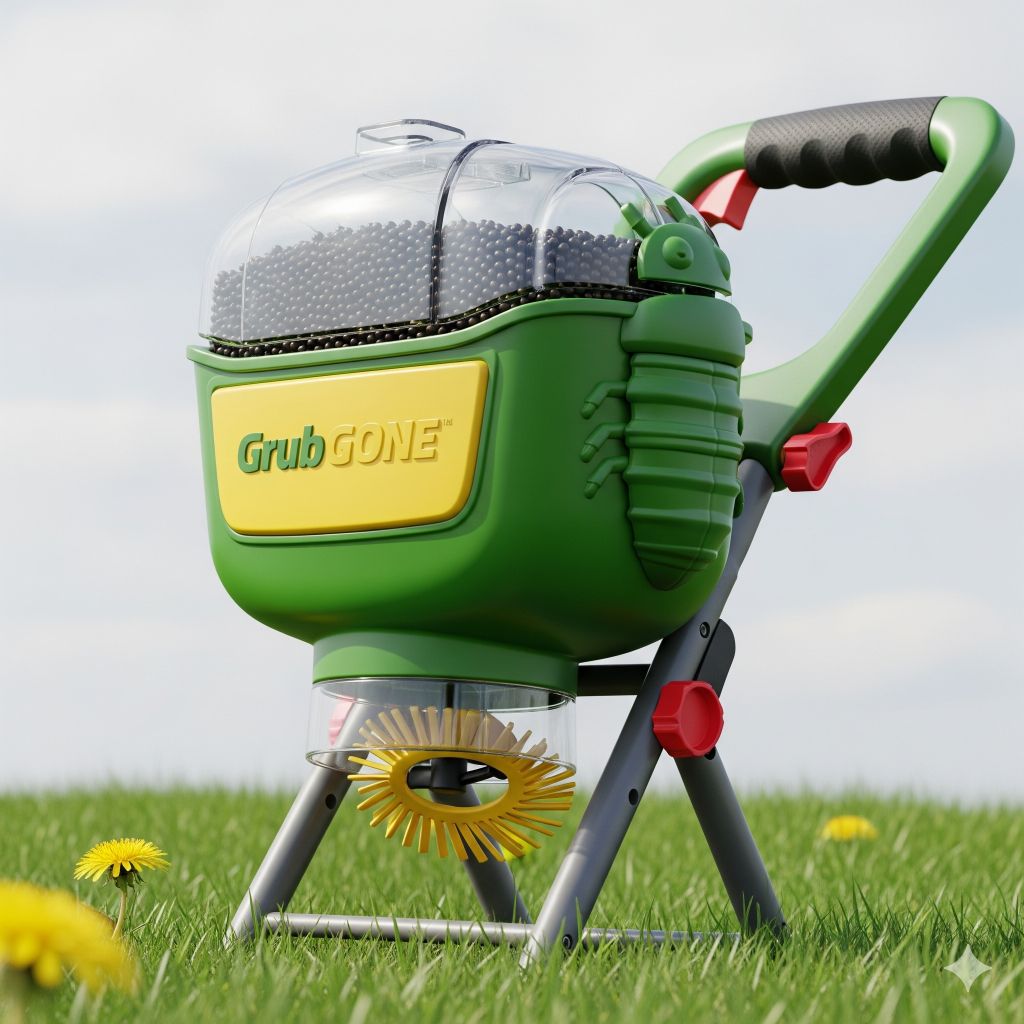
Grub-Gone spreader settings play a vital role in the successful application and effectiveness of grub control for turf and ornamental areas. This comprehensive guide provides charts, product comparisons, calibration steps, and expert tips to deliver precise, environmentally conscious, and efficient grub management across property types.
Grub-Gone Application Rates and Timing
Grub-Gone is applied as a granular biological insecticide targeting root-feeding grubs. The standard application rate is 3 lbs per 1,000 sq ft. One 10 lb bag typically covers about 4,000 sq ft of turf. Application timing is critical:
- Spring: Just after the ground has thawed, when grubs move up to feed near the root zone.
- Late Summer/Fall: When new grub larvae hatch and feed below turf surfaces, and larger grubs become active.
Ensuring irrigation soon after application helps the granules penetrate the root zone where grubs do the most damage.
Grub-Gone Spreader Settings Chart
To achieve optimal results, consult these baseline settings for popular spreader models. Settings may need small adjustments due to equipment wear, walking speed, and individual lawn conditions.
| Spreader Model | Setting / Control | Coverage per 1,000 sq ft |
|---|---|---|
| Scotts Precision Green Drop | 4–4.75 | 3 mph |
| Scotts R-8A | J–K (rotary), 11 | 3 mph |
| Andersons Rotary 2000 SR | K–L | 3 mph |
| Earthway Ev-N-Spred Rotary | 12–14 | 3 mph |
| LESCO Rotary (020093/705698) | E–F, 12–14 | 3 mph |
| Agrifab Rotary | 4–4.5 | 3 mph |
| Scotts Rotary (EdgeGuard DLX/Mini) | 3 | 5–6 ft swath |
| Prizelawn BF1 Pull-Behind | H | 3 mph |
- If a specific spreader model isn’t listed, reference the prill (granule) size of Grub-Gone (typically 150 SGN) and check the spreader’s own manual for equivalent settings.
- Fine-tune settings by calibrating to the desired rate as shown below.
Calibration and Fine-Tuning Steps
Calibration ensures the product is delivered at the right rate:
- Know the Application Rate: Grub-Gone standard rate is 3 lbs per 1,000 sq ft.
- Set Spreader: Begin at the recommended setting for your spreader.
- Test Strip: Measure an area (e.g., 250 or 500 sq ft) and spread Grub-Gone at normal pace.
- Weigh Product: Weigh how much is dispensed on the test strip. Calculate the rate by scaling up to 1,000 sq ft.
- Adjust Setting: If under-applying, increase the setting; if over-applying, decrease. Repeat testing as needed.
- Log Findings: Record the best setting for future reference; settings may shift due to spreader wear or seasonal humidity.
Tips for Effective Grub-Gone Application
Timing
- Apply when grubs are active. For curative control, late July through September is ideal. For preventive control, target early spring or just before adult beetles lay eggs.
- Monitor local pest cycles. Consult local horticultural resources or extension experts regarding grub life stages in the area.
Technique
- Uniform Coverage: Walk at a consistent pace and maintain slight overlaps for even distribution.
- Irrigate: Water treated areas with about 0.5 inches (1.25 cm) right after application to move granules into the root zone.
- Post-Application Care: Avoid mowing until after irrigation has fully incorporated the product into the soil.
Spreaders
- Handheld Spreaders: Use setting 3 for Scotts hand-held models.
- Drop Spreaders: Keep to settings between 4–5 for 3 mph walking speed.
Environmental Considerations
- Avoid excess runoff: Don’t apply during heavy rain or to saturated soil.
- Monitor health: Too wet or dry conditions can reduce efficacy; maintain moderate moisture before and after application.
Comparison: Grub-Gone vs. Other Grub Control Products
| Product | Mode of Action | Residue Concerns | Application Rate | Spreader Setting Diversity | Environmental Impact |
|---|---|---|---|---|---|
| Grub-Gone | Biological, safe for pets | None | 3 lbs/1,000 sq ft | Wide, compatible | Very low |
| Traditional Synthetic (e.g. Imidacloprid) | Chemical neurotoxin | Yes | 2–4 lbs/1,000 sq ft | Narrow, proprietary | Moderate–High |
| Milky Spore | Biological, specific | None | 1 tsp/4 sq ft | Requires fine dropped | Very low |
- Grub-Gone uses Bacillus thuringiensis to naturally target grubs without harming beneficial insects, providing flexibility across home and commercial spreaders.
- Synthetic controls may offer broader pest coverage but can leave hazardous residue and harm pollinators.
- Milky Spore targets Japanese beetle grubs specifically, requiring longer periods for visible effectiveness.
Application Example: Calculating Coverage
For a 5,000 sq ft lawn:
- Bag size: 10 lbs Grub-Gone (covers 4,000 sq ft).
- Total needed: 5,000/1,000=55,000 / 1,000 = 55,000/1,000=5 units × 3 lbs = 15 lbs.
- Purchase two 10 lb bags (covers up to 8,000 sq ft), set spreader as chart for your model, calibrate, and apply with steady, overlapping passes. Irrigate afterward.
Frequently Asked Questions
Can I apply Grub-Gone in both spring and fall?
Yes, spring targets grubs emerging from dormancy, while late summer/fall controls newly hatched and larger grubs for maximum effect.
Should I water before applying Grub-Gone?
Soil should be moderately moist. Always water after application to move the product into the root zone.
What if my spreader isn’t in the chart?
Use the prill size as a reference and calibrate with the recommended rate as outlined above.
Is Grub-Gone pet and pollinator safe?
Yes, when applied according to label directions, it is safe for pets, pollinators, and wildlife.
Troubleshooting and Maintenance
- Check spreader for obstructions and wear before use. Worn spreaders can deliver inaccurate amounts.
- Log each calibration test for future use. Weather and lawn conditions may affect results.
- Clean equipment after use to prevent buildup, corrosion, or clogs.
- Store Grub-Gone in a dry place to maintain product integrity.
Expert Lawn Care Tips
- Apply in the morning or evening to minimize evaporation and maximize soil absorption.
- Monitor treated areas over weeks; grub activity usually subsides within 2–4 weeks.
- For heavy infestations, consider follow-up applications or combine with proper turf maintenance (aeration, fertilization).
Grub-Gone Spreader Settings Reference Table
| Spreader Type | Setting | Application Rate | Notes |
|---|---|---|---|
| Scotts Rotary | 3 | 3 lbs/1,000 sq ft | Apply at 5–6 ft swath |
| Earthway Rotary | 12–14 | 3 lbs/1,000 sq ft | Consistent speed needed |
| Drop Spreader | 4–5 | 3 lbs/1,000 sq ft | Check coverage width |
| Handheld Spreader | 3 | 3 lbs/1,000 sq ft | Small areas, spot treat |
Conclusion
Mastering Grub-Gone spreader settings and application techniques ensures safe, effective control of turf-damaging grubs, with environmentally responsible practices, compatibility with most spreaders, and simple calibration steps. Regular observation, timely irrigation, and careful equipment maintenance make Grub-Gone a preferred choice for maintaining healthy, robust lawns and landscapes without unnecessary chemical risks.
- https://beetlegone.com/pages/grubgone-spreader-settings
- https://growitnaturally.com/products/grubgone
- https://www3.epa.gov/pesticides/chem_search/ppls/088347-00002-20130606.pdf
- https://www3.epa.gov/pesticides/chem_search/ppls/088347-00002-20140609.pdf

I’m David man behind Lawn Mowerly; I’ve been dealing with lawnmowers and Tractors with my father since I was a kid. I know every make and model and what each one is capable of and love helping people find the perfect equipment for their needs.
